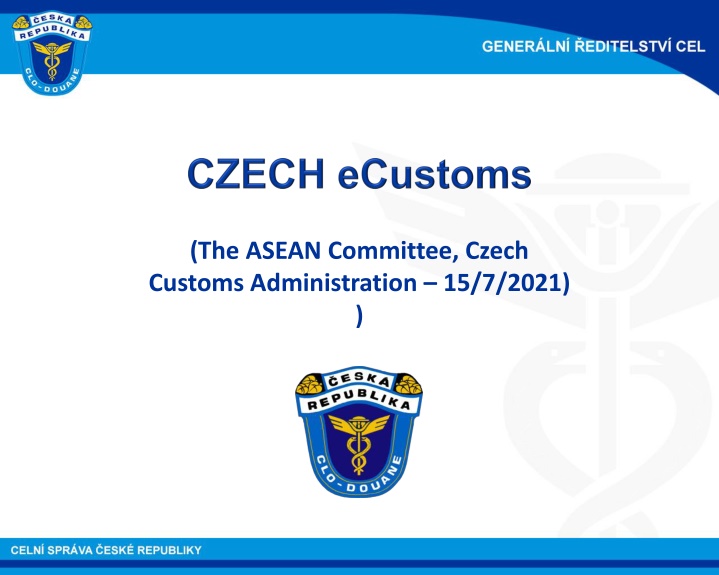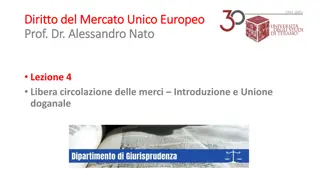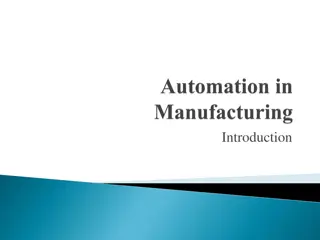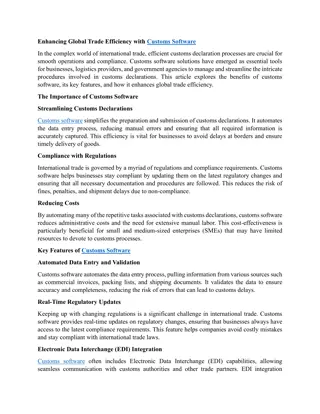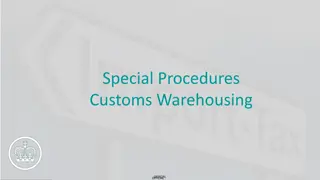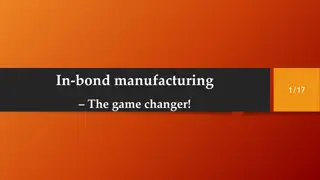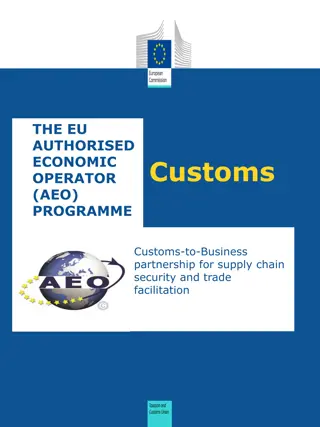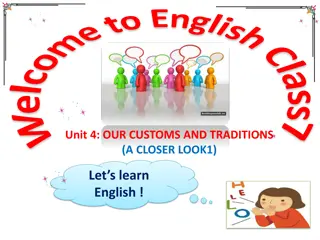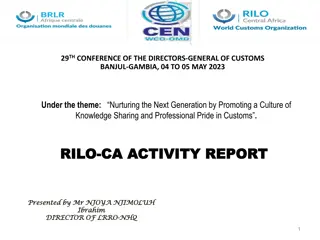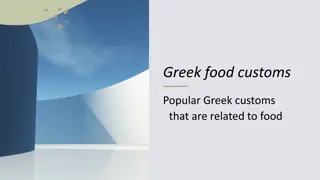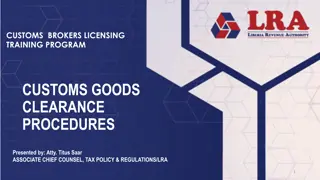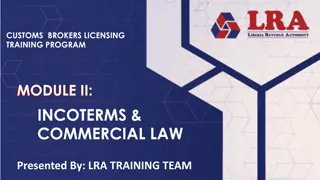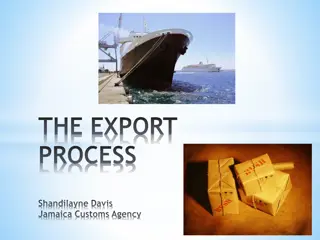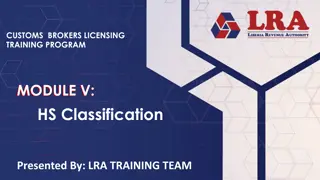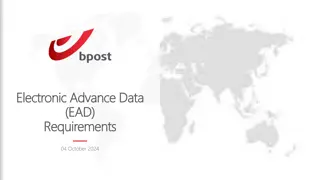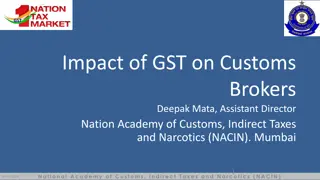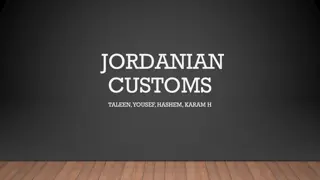Insights into Customs Legislation and Computerization Systems
Explore the framework of European and Czech customs legislation, focusing on Regulations No. 952/2013 and Acts relevant to Customs Administration. Delve into the digital transformation with the computerization of customs systems, emphasizing electronic customs clearances, EORI numbers, and trader identification/authorization processes.
Download Presentation

Please find below an Image/Link to download the presentation.
The content on the website is provided AS IS for your information and personal use only. It may not be sold, licensed, or shared on other websites without obtaining consent from the author.If you encounter any issues during the download, it is possible that the publisher has removed the file from their server.
You are allowed to download the files provided on this website for personal or commercial use, subject to the condition that they are used lawfully. All files are the property of their respective owners.
The content on the website is provided AS IS for your information and personal use only. It may not be sold, licensed, or shared on other websites without obtaining consent from the author.
E N D
Presentation Transcript
(The ASEAN Committee, Czech Customs Administration 15/7/2021) )
Customs European Legislation (basic overview) Regulation (EU) No 952/2013 of the European Parliament and of the Council of 9 October 2013 laying down the Union Customs Code Commission Delegated Regulation (EU) 2015/2446 of 28 July 2015 supplementing Regulation European Parliament and of the Council as regards detailed rules concerning certain provisions of the Union Customs Code Commission Implementing Regulation 24 November 2015 laying down detailed rules for implementing certain provision of Regulation (EU) No 952/2013 of the European Parliament and of the Council laying down the Union Customs Code (EU) No 952/2013 of the (EU) 2015/2447 of
Customs National Legislation (basic overview) Act No 242/2016 Coll., Customs Code Act No 17/2012., About Customs Administration of the Czech Republic Act No 500/2004, National Act on administrative procedure Act No 280/2009, Tax regulation
Computerization of customs systems (1) Customs clearance are fully electronic Electronic systems are being developed and constantly improved 12 IT systems Higher effectiveness of customs clearance, reduction of administrative barriers for traders E-Customs programme managed by European Commission to build non-paper environment in the EU
EORI number Article 9 of the UCC traders are obliged to have an EORI number for communication with customs authorities EORI database EORI number is validated by all information customs systems
Identification/authorization of traders All essential customs processes are based on electronic communication (lodgement of customs declaration) Development identification/authorization of persons in charge of the new methods for electronic Web platform cPortal as the trader is identified and authorised he can lodge any document or use several IT systems
Transit, export, import systems Certified declarations systems o commercial systems Web clients NCTS/AES and import o free of charge
AES Automated Export System (1) The economic operators can communicate with the Czech customs authorities in the framework of export customs proceedings in an electronic way e-Communication between COoExp and COoExt - electronic CD to CO of export - based on messages and conditions - e-certificate of exit of goods from EU for COoExp
AES Automated Export System (2) Through AES are processed export customs declarations for all export customs procedures: Release for export procedure, incl. Temporary export Release for re-export procedure Release for Outward processing
AES Automated Export System (3) Lodgement of the Export Customs declaration: Standard Procedure Simplified Procedure (Simplified Declaration or Entry in Declarant Rec.) Paper based declaration (fall-back procedure) Acceptance of the Export Customs Declaration Risk analysis - Control procedure Release the goods (issue Export Accompanying Document = EAD) e-Notification to COoExt Export movement to COoExt Endorse the exit of the goods by COoExt by e-message
NCTS transit system Customs supervision from point of entry to the final destination in EU (import) Customs supervision from point of departure to the point of exit from EU (export) Connection with NCTS systems of all MS Guarantee Communication between CO departure and CO destination Period for discharge of transit procedure (e.g. 8 days)
Temporary storage Discharge of transit procedure release into customs regime immediately o temporary storage procedure o Automatic solution of temporary storage 90 days for release into following customs procedure Guarantee Authorization for TST Transit procedure discharged by temporary storage procedure
Electronic systems for import (called e-Import ) Within e-Import project a new software environment has been developed (working in Windows) e-Import project consists of two essential parts First part: Entry Process (ICS) o Import Control System o The date of launching: 1 July 2009 Second part: Import Process (AIS) o Automated Import System o The date of launching: 1 November 2010
ICS Import Control System Entry processes relate to entry of goods to the EU territory and to temporary storage Ready for lodging, receiving and processing of an Entry Summary Declaration (ENS) according article 127 of Union Customs Code Ready for lodging of Notification of Arrival (NA) according article 133 of Union Customs Code Ready for lodging, receiving and processing of Temporary Storage Declaration (TSD) according article 145 of Union Customs Code
Entry Summary Declaration Entry Summary Declaration (ENS) shall contain the particulars necessary for risk analysis for security and safety purposes Risk analysis for security and safety purposes carries out Electronic Risk Management System (ERIAN) On the basis of the risk analysis the customs office of first entry decides whether to allow goods to enter the customs territory of the European Union
AIS Automated Import System (1) AIS is the second part of e-Import Ready for all processes at the Customs Office of Import in connection with lodgement of import customs declaration The economic operators can communicate with the Czech customs authorities in the framework of import customs proceedings in an electronic way
AIS Automated Import System (2) Through AIS are processed import customs declarations for all import customs procedures: Release for free circulation Customs warehousing Free zones Temporary admission End-use Inward processing
AIS Possibilities of lodgement (2) The transmission of electronic messages between the systems of the Czech Customs Administration and the economic operators functions in both directions It means that in reaction on their electronic lodgements economic operators obtain feedbacks on how their lodgements are treated As for the technological platform only the XML format is allowed, so neither email communication nor electronic data boxes are supported (allowed)
AIS Possibilities of lodgement (3) The usage of a commercial or private software which is certified (88% customs declaration items) The usage of a free public web application, available only Czech and English versions (10% customs declaration items) Customs declaration is lodged in written form, customs officer has to enter particulars of the declaration manually (2% customs declaration items)
Interconnection of systems Basic customs systems (NCTS, ECS, AIS) -interconnection with several IT systems, for example AIS: Authorization (ZJP/ASEO) Guarantee Management System (GLZ/GMS) Accounting System (ECDC) Risk Analysis system (ERIAN) NCTS/ECS EORI system and Simplification for Economic Operators PURPOSES - automatic verification of various data elements in customs declarations in relation to data in other systems and transmission of information relevant to other systems
Customs simplification Entry into declarant s records Goods is released by entry into records /supplementary customs declaration Simplified customs declaration / supplementary customs declaration Goods is released on the basis of customs non completed customs declaration (missing data or documents) Centralised customs clearance Customs declaration is lodged to different customs office, where goods is presented
Customs simplification in transit procedure Authorised consignee for TIR operation Presentation of goods on approved location Authorised consignor for Union transit Release of goods without presentation of goods Authorised consignee for Union transit Presentation of goods on approved location
Customs simplification in transit procedure Transit declaration with a reduced dataset Lodgement of TDD with a reduced dataset Electronic transport document as customs declaration
Special procedures Inward processing Outward processing End use Customs warehousing Temporary admission
ASEO database Electronic simplification, special procedures, approved location database of the authorizations for customs Automatic validation of authorization s data with data of customs declarations (evidence number of authorization, CN code, validity of authorization ) Validation of approved location based on evidence number of this location
Trader Portals Obligation information to use electronic system for exchange of Trader Portal ( for traders) and Customs portal (for customs) Customs Decisions eAEO eBTI INF REX
Thank you for your kind attention Mr. Tom Kocourek General Directorate of Customs t.kocourek@cs.mfcr.cz
